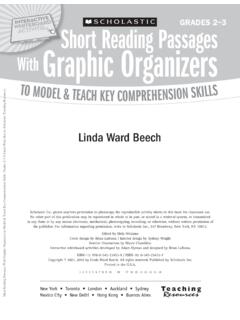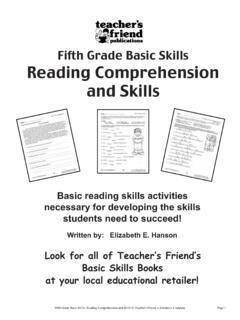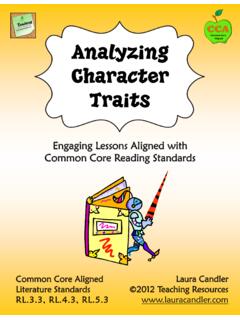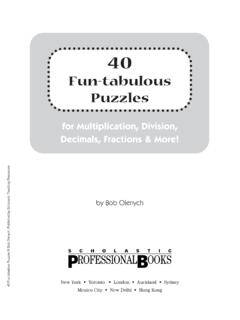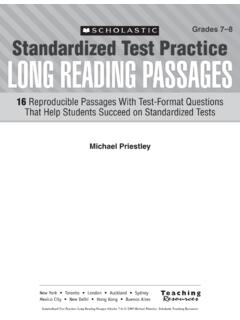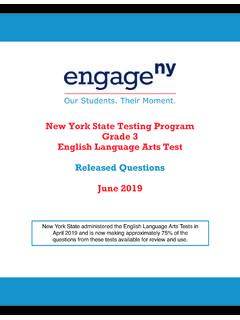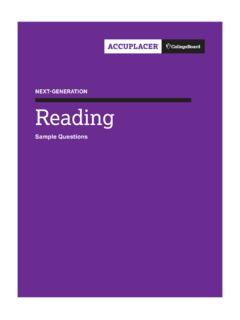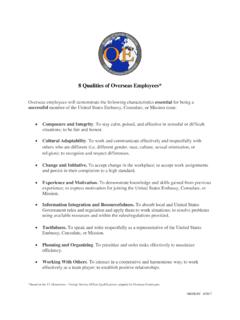Transcription of Grades 3–4 Standardized Test Practice LONG READING …
1 Grades 3 416 Reproducible passages With Test-Format Questions That Help Students Succeed on Standardized TestsMichael PriestleyStandardized Test Practice LONG READING PASSAGESS tandardized Test Practice : Long READING passages ( Grades 3-4) 2009 Michael Priestley, Scholastic Teaching ResourcesScholastic Inc. grants teachers permission to photocopy the reproducible pages from this book for classroom use. No other part of this publication may be reproduced in whole or in part, or stored in a retrieval system, or transmitted in any form or by any means, electronic, mechanical, photocopying, recording, or otherwise, without written permission of the publisher. For information regarding permission, write to Scholastic Inc., 557 Broadway, New York, NY by Mela Ottaiano Cover design by Brian LaRossa Interior design by Creative Pages, Inc.
2 Illustrations by Wilkinson Studios, Inc. ISBN-13: 978-0-545-08324-9 ISBN-10: 0-545-08324-9 Copyright 2009 by Michael Priestley. All rights reserved. Published by Scholastic Inc. Printed in the 2 3 4 5 6 7 8 9 10 40 15 14 13 12 11 10 09 Standardized Test Practice : Long READING passages ( Grades 3-4) 2009 Michael Priestley, Scholastic Teaching ResourcesContentsIntroduction ..4 READING passages : 1 Max s Big Adventure (fantasy) ..5 2 Brave Bessie Coleman (biography) ..10 3 Plants and People (informational article) ..14 4 The Clever Little Tailor (folk tale) ..18 5 Petrified Forest National Park (informational article) ..24 6 Missy Gerstein: Mystery Girl (realistic fiction) ..29 7 Insect Invasion (informational article) ..35 8 Westward on the Oregon Trail (informational article) ..40 9 Block City (poem).
3 44 10 Watermelon War (realistic fiction) ..47 11 Rachel Carson (biography) ..52 12 Where Giants Once Roamed (informational article) ..59 13 The Man, the Snake, and the Fox (folk tale) ..65 14 The Substitute and Starting School (poems) ..70 15 Life in Korea (informational article) ..74 16 Surprises (realistic fiction) ..80 Answer Key ..86 Student Scoring Record ..96 Standardized Test Practice : Long READING passages ( Grades 3-4) 2009 Michael Priestley, Scholastic Teaching Resources4 Introduction Many statewide assessments and Standardized tests now feature a greater variety of READING passages and passages of greater length than in the past . It is not uncommon for students to encounter READING passages that are four, five, or even six pages long . In addition to longer passages , many tests now include both multiple-choice and written-response questions, which may be worth 2 to 4 points.
4 Students are more likely to succeed on tests like these if they experience this kind of challenging comprehension task beforehand . That s the main purpose of this book: to help prepare students for READING and responding to longer READING passages .How to Use This Book This book provides 16 READING passages (both prose and poetry) from Grade 3 to Grade 4 in READING level . The prose ranges from two to four pages in length . Each of the poems is one page long . Each passage has 6 to 10 questions, including both multiple-choice and written-response . You may want to have students work through all of the 16 passages in sequence, or you may use them in any order . For example, you might choose passages that relate to the subject-area content that you are covering in class at a given time . For each passage that you choose, make a copy of the passage and the questions for each student.
5 Have students read the passage and then answer the questions on the page by marking the answer circles or writing their answers on the lines provided . After students have answered all of the questions, you can score their responses by referring to the answer key at the back of this book . You and your students may want to monitor their progress by recording their scores on the Student Scoring Record (page 96) .The answer key gives the correct answers to multiple-choice questions and example responses for written-response questions . In addition, the answer key indicates the READING comprehension or vocabulary skill tested by each question . You may find this information useful when evaluating which questions students answered incorrectly and planning for the kinds of instructional help they may need .Scoring Responses The comprehension Practice activities in this book include multiple-choice items and two kinds of written-response questions.
6 Each multiple-choice item is worth 1 point . Written-response questions may be worth 2 points or 4 points . (The number of points is indicated in parentheses at the end of the question .) Two-point responses generally require two parts or two pieces of information . Four-point responses generally require four parts or four pieces of information . Requirements and the point value for these responses are outlined in the answer key . You may award full or partial credit for a student s written response to a question . For example, on a 4-point question, students may earn 0, 1, 2, 3, or 4 points for a response, which follows the method of most Standardized tests . Standardized Test Practice : Long READING passages ( Grades 3-4) 2009 Michael Priestley, Scholastic Teaching Resources5 Name Date PASSAGE1 Directions: read Max s Big Adventure.
7 Then answer questions 1 s Big AdventureMax put his papers away and said, Mom, I finished my homework . Is it okay if I go and find myself a snack? Max s mother was busy tidying up . Just wait til I finish my chores, and I ll get you something to nibble on, she answered . Mom, I think I m big enough to get my own snack, Max protested . I know how, and I promise I ll be really, really careful . Mother stopped her work and looked up anxiously . Oh, no, it s much too dangerous in the daytime, she said . What if you are seen .. or caught? I can t allow it . Mom, I m not a baby mouse anymore! I ve gone hunting with Dad every night this week! I know where to go and what to do . I m hungry, and .. and I m bored in this mouse hole, and I m big enough to find my own snack! This was the day Mother Mouse had dreaded . Deep inside, she knew it was time to let her son leave the safety of the mouse hole by himself.
8 But first she had to warn him about the many dangers outside . Watch out for the cat . Watch out for the dog . Listen for people s footsteps . Don t go near the garbage disposal . Travel along the walls, never out in the open . And don t stay out a moment longer than you have to! Find a snack, and hurry right back to the mouse hole to eat it . For a minute, Max could hardly believe his own ears: Mom had actually said he could go out alone! The young mouse shivered with excitement, his hunger forgotten . This was the day he had been longing for . At last he would have some adventures!The two mice peered out of the mouse hole into the people s living room . The room was quiet and deserted . The coast is clear, breathed Mom . Good luck, Max, and be careful! Standardized Test Practice : Long READING passages ( Grades 3-4) 2009 Michael Priestley, Scholastic Teaching Resources6 Name Date Max darted out of the mouse hole quickly before Mom could change her mind.
9 He sprinted along the living room wall, turned the corner, and stopped at the door to the kitchen. He used his eyes, his ears, and his nose to check for people and pets, just as Father had taught him . All was quiet, so Max scampered along the wall toward the table . If he was lucky, no one had swept the floor after lunch, and a good snack would be easy to find . The people must have had cookies for lunch . There were crumbs everywhere, and Max remembered his hunger . Greedily he started to eat, forgetting Mom s instructions to hurry home. He had just stuffed a fat chocolate chip into his mouth when he heard the front door creak . Max froze and made himself as small as possible . As long as someone was in the living room, his way back to the mouse hole was blocked . What would happen if someone came into the kitchen? I should hide in the broom closet, thought Max.
10 That s what Father said to do in times of trouble . But Max was frightened, and his legs did not seem to be working properly . Instead of running to hide, he tried to make himself invisible. He squeezed his eyes shut, held his breath, and put his paws over his ears . People were talking in the living room, and one word caught Max s attention: mousetraps .The woman asked, Where did you put the mousetraps? One is under the kitchen sink, one is just inside the back door, and one is in the broom closet, the man replied . Max started to tremble . What if I had gone into the broom closet? he thought . I might have been caught in a trap! But I didn t, and I m safe, and now it s up to me to get home and warn Dad about the traps . A new, grown-up feeling came over Max, and he forgot his fear . He knew what he had to do: find a place to hide until it was safe to go home.
